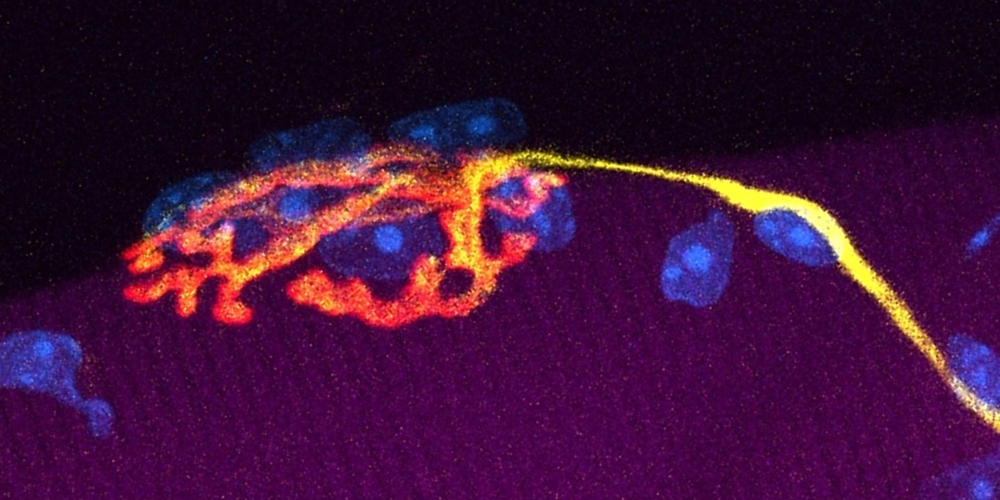Replacing bone saws with smart lasers
Using lasers rather than scalpels and saws has many benefits in surgery. Yet they are only used in isolated cases. But that could be about to change: laser systems are getting smarter and better all the time, as a research team from the University of Basel demonstrates.
05 December 2023 | Angelika Jacobs
Even back in 1957, when Gordon Gould coined the term “laser” (short for “Light Amplification by Stimulated Emission of Radiation”), he was already imagining the possibilities for its use in medicine. Surgeons would be able to make precise incisions without even touching the patient.
Before that could happen, however, there were – and still are – many hurdles to overcome. Manually controlled light sources have been superseded by mechanical and computer-controlled systems, in order to reduce injuries caused by clumsy handling. Switching from continuous beams to pulsed lasers, which turn themselves rapidly on and off, has reduced the heat they produce. Technical advances allowed lasers to enter the world of ophthalmology in the early 1990s. Since then, the technology has moved on in other areas of medicine too, but only in relatively few applications has it replaced the scalpel and the bone saw.
Safety concerns are the most important hurdle: how can we prevent injury to the surrounding tissue? How closely can the cutting depth be controlled so that deeper layers of tissue are not accidentally damaged?
Researchers at the University of Basel have just made an important contribution to the safe and precise use of lasers with their recent publication in the specialist journal Lasers in Surgery and Medicine. The research team, led by Dr. Ferda Canbaz at the Department of Biomedical Engineering in Basel and Professor Azhar Zam, formerly of the University of Basel but now based at New York University, has developed a system that combines three functions: it cuts bone, controls the cutting depth and differentiates between different tissues.
Three lasers directed at one spot
These three functions are carried out by three lasers that are aligned to focus on the same spot. The first laser serves as a tissue sensor in that it scans the surroundings of the site where the bone is to be cut. Pulses are sent with this laser to the surface at regular intervals, so to speak vaporizing a tiny bit of tissue each time.
The composition of this vaporized tissue sample is measured with a spectrometer. Each type of tissue has its own individual spectrum – its own signature. An algorithm processes this data and creates a kind of map that shows where the bones are located and where the soft tissue is.
Not until all of this has been completed does the second laser, which cuts bone, activate, and then only in places where bones rather than soft tissue are shown on the map that has just been generated. At the same time, the third laser – an optical system – measures the depth of the cut and checks that the cutting laser is not penetrating more deeply than planned. During the cutting phase, the tissue sensor also constantly monitors whether the correct tissue is being cut.
Autonomous control
“The special thing about our system is that it controls itself – without human interference,” sums up laser physicist Ferda Canbaz.
The researchers have so far been testing their system on femur bones and tissue from pigs, acquired from a local butcher. They were able to prove that their system works accurately down to fractions of a millimeter. The speed of the combined laser also approaches that of a conventional surgical procedure.
The research team is currently working on making the system smaller. They have already got it down to the size of a matchbox when combining the optical system and the cutting laser alone (click here for the original pubilcation). Once they have added the tissue sensor and managed to miniaturize the entire system further, they should be able to fit it into the tip of an endoscope to carry out minimally invasive operations.
Less invasive surgery
“Making more use of lasers in surgery is a worthy ambition for a number of reasons,” emphasizes Dr. Arsham Hamidi, lead author of the study. Contact-free cutting somewhat reduces the risk of infections, he points out. “Smaller and more precise incisions also mean that the tissue heals more rapidly, and that scarring is reduced.”
Cutting in a controlled manner using lasers also permits new cutting shapes to be applied, so that, for instance, a bone implant could be physically interlocked with the existing bone. “One day we might be able to do without bone cement completely,” adds Ferda Canbaz.
There are also other areas of surgery where this kind of combined setup would be useful: it might make it possible to distinguish tumors from the surrounding healthy tissue with greater precision, and then to cut them out without removing an unnecessary amount of the neighboring tissue. One thing is certain: Gordon Gould’s vision of the laser as a versatile medical tool is drawing ever closer.
Original publication
Arsham Hamidi, Yakub A. Bayhaqi, Sandra Drusová, Alexander A. Navarini, Philippe C. Cattin, Ferda Canbaz, Azhar Zam
Multimodal feedback systems for smart laser osteotomy: Depth control and tissue differentiation
Lasers in Surgery and Medicine (2023), doi: 10.1002/lsm.23732
Editor's note, Laser ins Surgery and Medicine (2023), doi: 10.1002/lsm.23736



